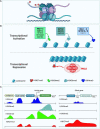The role of histone methyltransferases in neurocognitive disorders associated with brain size abnormalities
- PMID: 36845425
- PMCID: PMC9950662
- DOI: 10.3389/fnins.2023.989109
The role of histone methyltransferases in neurocognitive disorders associated with brain size abnormalities
Abstract
Brain size is controlled by several factors during neuronal development, including neural progenitor proliferation, neuronal arborization, gliogenesis, cell death, and synaptogenesis. Multiple neurodevelopmental disorders have co-morbid brain size abnormalities, such as microcephaly and macrocephaly. Mutations in histone methyltransferases that modify histone H3 on Lysine 36 and Lysine 4 (H3K36 and H3K4) have been identified in neurodevelopmental disorders involving both microcephaly and macrocephaly. H3K36 and H3K4 methylation are both associated with transcriptional activation and are proposed to sterically hinder the repressive activity of the Polycomb Repressor Complex 2 (PRC2). During neuronal development, tri-methylation of H3K27 (H3K27me3) by PRC2 leads to genome wide transcriptional repression of genes that regulate cell fate transitions and neuronal arborization. Here we provide a review of neurodevelopmental processes and disorders associated with H3K36 and H3K4 histone methyltransferases, with emphasis on processes that contribute to brain size abnormalities. Additionally, we discuss how the counteracting activities of H3K36 and H3K4 modifying enzymes vs. PRC2 could contribute to brain size abnormalities which is an underexplored mechanism in relation to brain size control.
Keywords: autism; brain size; chromatin; histone methyltransferase; macrocephaly; microcephaly; neurodevelopment.
Copyright © 2023 Ritchie and Lizarraga.
Conflict of interest statement
The authors declare that the research was conducted in the absence of any commercial or financial relationships that could be construed as a potential conflict of interest.
Figures


Similar articles
-
H3K36 methylation antagonizes PRC2-mediated H3K27 methylation.J Biol Chem. 2011 Mar 11;286(10):7983-7989. doi: 10.1074/jbc.M110.194027. Epub 2011 Jan 14. J Biol Chem. 2011. PMID: 21239496 Free PMC article.
-
Histone H2A ubiquitination inhibits the enzymatic activity of H3 lysine 36 methyltransferases.J Biol Chem. 2013 Oct 25;288(43):30832-42. doi: 10.1074/jbc.M113.475996. Epub 2013 Sep 9. J Biol Chem. 2013. PMID: 24019522 Free PMC article.
-
The trithorax group proteins Kismet and ASH1 promote H3K36 dimethylation to counteract Polycomb group repression in Drosophila.Development. 2013 Oct;140(20):4182-92. doi: 10.1242/dev.095786. Epub 2013 Sep 4. Development. 2013. PMID: 24004944 Free PMC article.
-
Polycomb-mediated histone modifications and gene regulation.Biochem Soc Trans. 2024 Feb 28;52(1):151-161. doi: 10.1042/BST20230336. Biochem Soc Trans. 2024. PMID: 38288743 Review.
-
Understanding histone H3 lysine 36 methylation and its deregulation in disease.Cell Mol Life Sci. 2019 Aug;76(15):2899-2916. doi: 10.1007/s00018-019-03144-y. Epub 2019 May 30. Cell Mol Life Sci. 2019. PMID: 31147750 Free PMC article. Review.
Cited by
-
Association Between COVID-19 and Neurological Diseases: Evidence from Large-Scale Mendelian Randomization Analysis and Single-Cell RNA Sequencing Analysis.Mol Neurobiol. 2024 Sep;61(9):6354-6365. doi: 10.1007/s12035-024-03975-2. Epub 2024 Feb 1. Mol Neurobiol. 2024. PMID: 38300446 Free PMC article.
-
Diagnosis and recombinant human growth hormone treatment of Wiedemann-Steiner syndrome: discovery of novel KMT2A variants and review of existing literature.BMC Pediatr. 2025 Jul 3;25(1):523. doi: 10.1186/s12887-025-05751-0. BMC Pediatr. 2025. PMID: 40604511 Free PMC article. Review.
-
Trio-based whole exome sequencing in patients with ectopic posterior pituitary.Front Pediatr. 2024 Aug 2;12:1334610. doi: 10.3389/fped.2024.1334610. eCollection 2024. Front Pediatr. 2024. PMID: 39156017 Free PMC article.
-
Chromatin modifiers in neurodevelopment.Front Mol Neurosci. 2025 May 21;18:1551107. doi: 10.3389/fnmol.2025.1551107. eCollection 2025. Front Mol Neurosci. 2025. PMID: 40469903 Free PMC article. Review.
-
CAGI6 ID panel challenge: assessment of phenotype and variant predictions in 415 children with neurodevelopmental disorders (NDDs).Hum Genet. 2025 Mar;144(2-3):227-242. doi: 10.1007/s00439-024-02722-w. Epub 2025 Jan 9. Hum Genet. 2025. PMID: 39786577 Free PMC article.
References
-
- Agger K., Cloos P., Christensen J., Pasini D., Rose S., Rappsilber J., et al. (2007). UTX and JMJD3 are histone H3K27 demethylases involved in HOX gene regulation and development. Nature 449 731–734. - PubMed
-
- Andrews P., Hulette C. (1993). An infant with macrocephaly, abnormal neuronal migration and persistent olfactory ventricles. Clin. Neuropathol. 12 13–18. - PubMed
Publication types
Grants and funding
LinkOut - more resources
Full Text Sources

